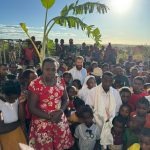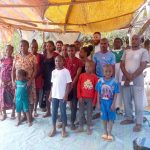Aventures missionaire – Madagascar
In the bush with the island’s forgotten people
Publié le 18/07/2025

Inauguration d’une chapelle de brousse en mai 2025. Au centre, le père Gabriel.
Seven years after being sent on mission to Madagascar, what are your current activities and location?
Since February 2024, I have been the parish priest at the Holy Family parish in the small town of Mandritsara in the Northeast of Madagascar. Our parish serves some sixty scattered villages in which a small, nascent Christian community gathers regularly to pray. The work is immense at all levels: learning to pray and bear witness to the Gospel of Jesus Christ, teaching, educating, and accompanying the many thousands of bush villagers who are the great forgotten in Madagascar. Neither the State, nor the NGOs, nor the various Christian churches really care about them. Access to drinking water, health, education, tracks and paths, agriculture, infrastructure… so many exciting projects, each of which could keep you busy for a lifetime.
Where to start? What should you do? Who can you rely on? And what structures should you use?
We have to do a little bit of everything when we are on mission. We have to ‘get it sorted’, just get by as best we can. (There is a Malagasy phrase ‘Mila midemerde isika’ which neatly reflects the French ‘se démerder!’).What I love doing is going into the bush to these remote, isolated villages. Generally, we go as a small team of Christians. Usually on foot. And every moment of these trips is an adventure, an encounter with providence itself!
Faced with the structural and cultural difficulties of the island, how can we help young people move towards a better future?
We’re not short of hope or courage, but we are somewhat overwhelmed. The Church itself is overwhelmed. There is a huge number of young people, and family units are often unstructured and broken. 4G antennas are proliferating even in the most remote places, and social media is bombarding the young with information and images. It’s very shocking for these young people from the bush who have nothing. Education in schools is limited. Elders and parents have less and less authority and sometimes seem to have given up. Young people very often see their futures as having no opportunities, just blocked.
What can be done?
There is enormous vitality and great strength in the young people I meet. At the same time, more hidden, there is great suffering. It makes me suffer to see that the Church is failing to accompany them in the way that they need. But how can we do this? How? With so few resources. Providence must know this much better than we do. Often, prayer is our best solution. For to pray is to recognize one’s limitations and, above all, to recognize that God is good and that he holds dominion over the world.
How, more widely, is the MEP mission in Madagascar doing?
Our meeting of MEP colleagues in the Indian Ocean has just ended. We talked at length about our missions, our challenges, and the projects that await us. We are sometimes a little disoriented because there are many priests and religious, both men and women, and they often do good work in our mission dioceses. So, we sometimes wonder about our role. But when we are fully involved in the mission, then we understand that we all have our place and that is our whole place. We have to learn to work with the local Church, but without losing our special nature and our pioneering missionary spirit.
After managing the construction of the Divine Mercy mosaic, what are your next challenges and projects?
The great mosaic project for the Port-Bergé sanctuary was the trigger for an even greater wonderful project. A few young people who trained for this first mosaic wanted to continue the adventure of creation and artistic achievement in the service of the mission of the Church to proclaim the Gospel. The small Mandrakizay workshop, located in Antananarivo, aims to evangelize with its hands, through the works it creates. Paintings, mosaics, small stained-glass windows, etc. Nothing grandiose – and a lot of incompetence – but, in such a large country that has only recently discovered the power of the image, art must gradually assume its rightful place. And not just any art: art that is created with patience, through the mastery of beautiful techniques and through the love of a job well done. So many challenges that I want to pass on to the small number of young people who are training in this workshop and who, I hope, will one day be able to find their way and make their voices heard and – in this way – touch souls through the work of their hands. What greater gift could I hope to pass on to the Malagasy youth? Providence definitely knows what it is doing.
As told by Father Gabriel de Lépinau to the editors
- Inauguration d’une chapelle de brousse en mai 2025. Au centre, le père Gabriel.
- Tournée en brousse dans la région de Mandritsara

